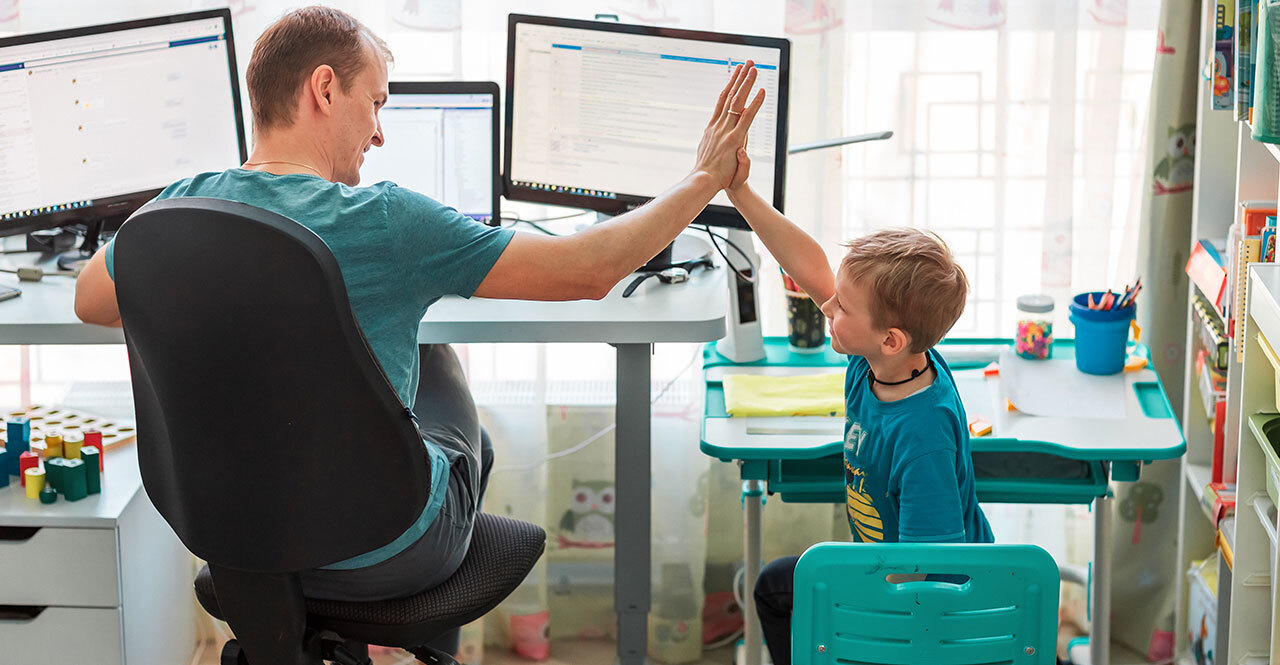 Reading Time: 6 minutes
Reading Time: 6 minutesWorking from home has never been more common. While it has been growing for years, 2020 brought a whole new era of remote working. For those who have been stuck in an office for their entire career, perhaps the thought of being able to work from home was a dream come true. It definitely has its advantages: no commute, no dress code, no constant supervision, and more flexibility to mix your personal needs with your work day.
It would be a mistake to think, however, that just because you’re at home you automatically have total control over the situation. Unlike an office, working at home offers little inherent structure. There are a lot of distractions. TV, kitchen, and all your personal comforts at your fingertips can pull you from the job at hand and into the murky reality of the home/work situation.
5 Ways You Can Create A Work From Home Situation That Works
While it’s tempting to think that working from home is superior in every way, it has its own challenges. That structure that offices offer—the supervision, the rigor, the consistency, and the focused atmosphere—actually have some benefits. With a little attention, you can create a work from home structure that incorporates the best of both worlds.
Using practices like these can help you create a sense of calm and focus around your work, something that most of us could use more of these days. The Whole Life Challenge offers many practices for your well-being like these to help generate more calm and peace of mind in your workday and beyond.
- Create a space that’s conducive to work
- Suit up and show up
- Work on a set schedule
- Break for lunch
- Program breaks into your day
Create a space that’s conducive to work.
It’s normal for many people, when they work at home from time to time, to plop down at the kitchen table and work. It’s not the best situation for long-term working if you can avoid it. Not only does it begin to blur the lines about what home is primarily for, it offers little protection from distractions, disturbances, or temptations.
The best situation would be a separate space to work in. Many (if not most) of us, however, don’t just have an extra room lying around waiting to be used as an office. Just because you don’t doesn’t mean you can’t shift your environment to a working environment with a few tricks.
- Put on music when you work. Find music that is pleasant but unobtrusive. Not only will it help with background noise as a distraction, it will start to signal your mind that it is work time. When it’s playing softly in the background, you’re “at the office.” When the day is done and you’re going home, shut it off. Try not to use your favorite music. Not only do you not want this to be about the music, you may not want to begin to associate the music you love with work.
- Turn off lights in other areas of the house. Effectively creating a home space and a work space, by turning off the lights in your bedroom and other areas where you aren’t working, you’ll better focus your attention on the area set up for work.
- Use a token to focus you. Take advantage of a strategy that has been used by spiritual practitioners for years. Just like those who create sacred spaces in ordinary parts of their home by using specific objects to define it and shape it psychologically, you can use a few specific objects to temporarily transform your home space to a work one. Whether it’s a framed family photo, a stapler, or a World’s Best Dad (or Mom!) coffee mug, a token object or two can help to frame the space you’re in for a specific purpose while it’s in play.
Suit up and show up.
However nice it feels to sit down in front of your computer in your PJs, you’ll feel much less like you’re home sick (and who likes to work when they’re home sick) if you maintain a morning routine that involves the things you did when you worked in an office, like showering and changing your clothes. Now, you’re at home, so you can probably be a little more casual than if you were heading to the office, but suiting up and the routines you use to start your day have a psychological effect that can better put you in a “working” state of mind.
It may help to think of it another way. How would you want to look, with respect to your work, if your boss or supervisor were to stop by? Just because no one is watching doesn’t mean you can’t (or shouldn’t) approach your work as if someone is.
It’s a practice that helps with accountability—the willing acceptance of a responsibility to yourself or someone else to achieve certain results.
Work on a schedule.
One of the biggest challenges we face, whether we work in an office or not, is separating work from personal life. Starting to work from home can make that distinction much more difficult to make. One of the best things you can do for yourself is to set a time when you clock in and a time when you clock out.
If you don’t start work until 9:00am, try and make it a practice to not open your email (especially once you pick up your phone in the morning) or start working on any projects before that time. If you knock off at 5, log off and close down everything work related when the day is done. It sounds simple, but when home and office collide, it becomes more difficult to draw bright lines between them.
Now you may have a relationship with work where there have been expectations to be available morning to night, whether you’re at the office or not. Your personal situation with your own job may be unique. However, it pays to be conscious of dividing work from personal life when your home becomes your office. Not only will this help with your sleep (working through the evening can be a big disruptor of sleep habits), you will maintain personal time for yourself and your relationships that is all your own.
Break for lunch.
Being 20 feet from your kitchen can be a big distraction when you work from home. In addition to having a good breakfast, taking time to break for and make (or buy) lunch can help stave off snacking throughout the day. Even if you’re not in the habit of snacking when you’re at the office, working at home provides a completely different set of temptations and attitudes.
Making it a practice to stop what you’re doing and sitting down to eat (whether you prepare it or go out to grab it) will promote eating healthier meals and contribute to a work/rest rhythm that can help with the constant temptation to wander away from your desk.
Joining the Whole Life Challenge provides the kind of accountability to good nutrition that working from home calls for. Along with habits that promote movement, sleep, and well-being, the Challenge will give you the motivation to stay focused around your eating habits and make work-at-home a workable situation.
Program breaks into your day.
At the end of the day (figuratively, of course), working at home is not the same as working at the office. Your home is a different place with a different energy. It will pay off to treat it differently from your workplace. Start by allowing yourself regular breaks throughout the day. Whether it’s 90 minutes of work with a 30 minute break or 30 minutes of work with a 10 minute break, find a rhythm that allows you to release the tension that can build when you treat your home like an office.
Taking that break to stretch, exercise, or even just get outside can help keep you healthy, active, and refreshed—things that working at home can sometimes take their toll on.
Even with 10-minute breaks, you can fulfill the minimum exercise and stretching requirements the Whole Life Challenge calls for while maintaining a working rhythm that keeps you and your boss happy.
As we all move forward, there is a good chance that many of us will continue working at home, at least part-time for the foreseeable future. Being conscientious about the situation will help you create something that works and make it as productive and stress-free as it possibly can be.
The Whole Life Challenge gives you the structure and support you need to be able to put habits and practices like these into action every day. Join now and build the habits you need to manage daily stress and uncertainty and build health, well-being, and resilience for the future.







